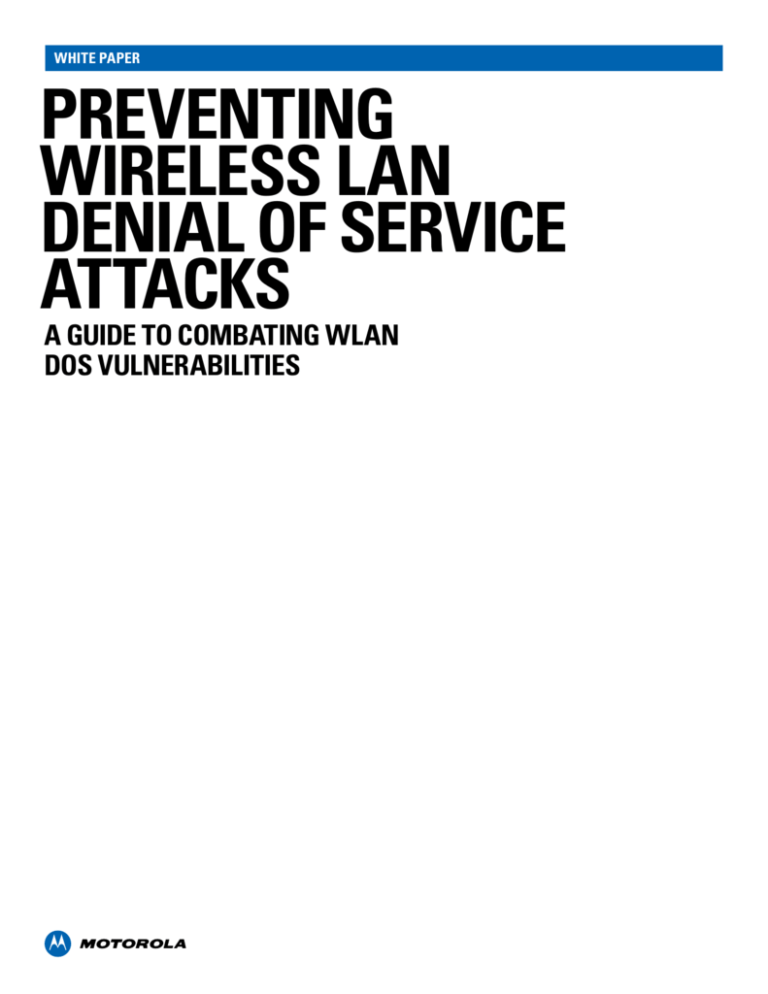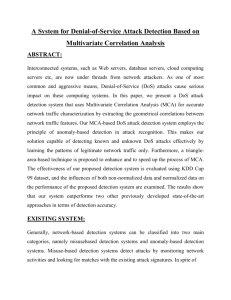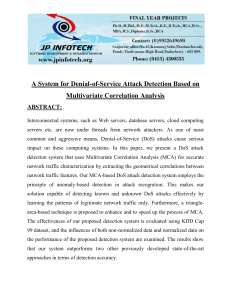
white paper
PREVENTING
WIRELESS LAN
DENIAL OF SERVICE
ATTACKS
A Guide to combating WLAN
DoS Vulnerabilities
white paper
PREVENTING WIRELESS LAN DENIAL OF SERVICE ATACKS
Executive Summary
Wireless communications that use a shared Radio Frequency
(RF) medium are often vulnerable to Denial of Service (DoS)
attacks. Wireless Local Area Networks (WLAN) based on
the IEEE 802.11 standard are no exception. In addition to
brute force Physical (PHY) layer jamming attacks, WLANs
are susceptible to various Media Access Control (MAC)
vulnerabilities that can lead to DoS. This paper provides
an overview of various WLAN DoS scenarios and available
countermeasures to detect and mitigate them.
PAGE 2
white paper
PREVENTING WIRELESS LAN DENIAL OF SERVICE ATACKS
WLAN Denial of Service Overview
WLANs use the 2.4 and 5 GHz license-free spectrum
for communication. This spectrum is shared by other
wireless devices and protocols such as cordless phones,
microwave ovens, Bluetooth devices, etc. These devices
and protocols often do not coexist well together and
can create mutual interference when co-located and
operating concurrently. WLANs use the IEEE 802.11
protocol to avoid collisions between different devices
and allow fair sharing of the medium. WLAN Denial of
Service can be intentional (by an attacker in the vicinity)
or unintentional (neighboring devices interfering with
each other) as illustrated
in Figure 1.
UNINTENTIONAL
(e.g. microwave ovens)
PHYSICAL
LAYER (1)
INTENTIONAL
(e.g. RF Jammers)
WLAN
DoS ATTACKS
UNINTENTIONAL
(e.g. neighboring Wi-Fi)
MAC LAYER (1)
INTENTIONAL
(e.g. WLAN-Jack, void11)
Figure 1: Denial of Service scenarios for WLANs
Physical Layer Vulnerabilities
WLAN devices sense the RF medium to determine if the
channel is free before transmitting their own packets.
The protocol is referred to as Carrier Sense Multiple
Access with Collision Avoidance (CSMA/CA). In CSMA,
a device wishing to transmit has to first listen to the
channel for a predetermined amount of time so as to
check for any activity on the channel. If the channel is
idle, the device is allowed to transmit. If the channel
is busy, the device has to defer its transmission.
Collision Avoidance schemes tend to be less “greedy”
when it comes to grabbing the channel and back off
transmission for random intervals if they sense activity.
In essence, WLANs are designed to “play nice” on the
shared communication medium.
By contrast, devices such as microwave ovens simply
spew energy in the 2.4 GHz band when they are
powered up. Other devices such as wireless video
cameras might use a continuous wave modulation
scheme where they are always radiating energy on a
given RF channel. If these devices are operating in the
vicinity of a WLAN, they can effectively shut down all
WLAN communication because devices will defer their
transmissions until they sense that the medium is idle.
Malicious RF jammers are also freely available on the
internet. These devices are illegal and are specifically
designed to disrupt wireless communications. Figure 2
shows a handheld, quad-band, cellular and 2.4 GHz band
jammer that uses a 6.0V NiMH battery pack with an
approximate battery life of one hour. The device has a
total output power of 1200 mW (a typical WLAN access
point normally operates at 100 mW). Such a device
can effectively block WLAN communication within a
30 meter radius. Very high power jammers capable of
radiating 200 W of power, effective over a 1 km, are
also available in the black market.
Figure 2: A wireless jammer
for 2.4 GHz and cell phone
(source: Global Gadget UK Ltd.)
PAGE 3
white paper
PREVENTING WIRELESS LAN DENIAL OF SERVICE ATACKS
MAC Layer Vulnerabilities
The 802.11 MAC is particularly vulnerable to DoS. The
current standard protects only data frames and leaves
various control and management frames subject to
manipulation by an attacker. Since the ratification of the
IEEE 802.11i standard in 2004, WLANs have been able
to provide strong authentication of wireless devices
and encryption of data traffic. The 802.11i standard
uses the IEEE 802.1X Extensible Authentication Protocol
(EAP) to guarantee that only authorized devices gain
access to the wireless network and uses the Advanced
Encryption Standard (AES) to guarantee confidentiality
and integrity of the data communications between
authenticated devices. IEEE 802.11i is the basis for the
WPA2 (Wi-Fi Protected Access 2) industry standard.
A major limitation in the 802.11i standard is that no
protection is available for management or control
frames that establish connections and, in general,
affect the behavior of WLANs. Tools such as “wlan
jack”, “hunter-killer” and “void11” exploit the lack of
management and control frame protection to mount DoS
attacks in WLANs.
Management Frame Exploits
One of the most popular WLAN DoS attacks is based
on spoofed deauthentication and disassociation
frames as depicted in Figure 3. These management
frames, like other 802.11 management frames, are not
authenticated. As such, an attacker can spoof the MAC
address of an AP and send a deauthentication
frame to a client, or vice versa. The attacker can
periodically scan all channels and transmit spoofed
deauthentication messages to valid clients,
terminating their connection. Deauthentication is not
a request, it is a notification. When the station hears
a deauthentication frame, it had no cryptographic
mechanism to determine whether the frame actually
came from the AP. It terminates its wireless session and
may attempt to reauthenticate. The attacker can keep
transmitting deauthentication frames preventing any
data communication from happening between the AP
and station, despite the authentication and encryption
that exists for data traffic, resulting in a successful DoS
attack. Using the same basic principle, an attacker can
spoof the source of other management or control frames
that result in DoS.
A spoofed disassociation frame also produced the same
end result – disassociating the client from the AP. A
deauthetication attack is slightly more effective than
disassociation since the client has to first
re-authenticate and then re-associate, i.e. do more work
to re-establish the wireless connection.
Power Save Exploits
Another DoS attack in WLANs exploits the power
saving mechanism in the standard. Mobile WLAN
clients are allowed to enter a sleep state during which
their WLAN radio is disabled to conserve battery
life. When an associated client is in a sleep state,
the AP buffers any traffic destined for the client. The
client wakes up periodically and polls the AP for any
buffered traffic, which the AP delivers and subsequently
discards. An attacker can send a spoofed power save
poll message, while the client is still sleeping, causing
the AP to transmit and discard any buffered traffic. It is
also possible to trick the client into thinking that there
are no buffered frames. Bufferred frames at the AP are
advertised in a Traffic Indication Map (TIM). An attacker
can spoof a TIM, convincing the client that there is no
buffered traffic, causing the client to immediately go
back to the sleep state, resulting in the frames for the
client eventually getting dropped.
AP
SPOOFED
DEAUTHENTICATION
& DISASSOCIATION
FRAMES
CLIENT
ATTACKER
Figure 3: DoS attack using spoofed deauthentication and/or
disassociation messages
PAGE 4
white paper
PREVENTING WIRELESS LAN DENIAL OF SERVICE ATACKS
Media Access Control Vulnerabilities
AThe 802.11 MAC is designed for collision avoidance
and fair sharing of the RF medium. The fundamental
assumption behind fair sharing, of course, is that
devices are following the protocol. The basic protocol
requires 802.11 devices to contend for the channel
during a contention window of time as illustrated in
Figure 4. Devices wait for a random backoff period,
before sensing the medium and initiating transmission.
Once a device has initiated a transmission, other
devices wait for the channel to be free before
transmitting. A typical MAC frame includes a duration
field that tells other devices the length of time (including
acknowledgement, ACK) for which the medium will be
busy. This facilitates virtual carrier sensing in addition
to physical carrier sensing. APs and stations keep track
of transmission durations of other devices they hear to
determine when the next transmit opportunity will arise.
Further, by spoofing the duration field with very large
values, the attacker can convince legitimate stations
that the medium is busy and prevent them from gaining
access. Several control frames such as Clear to Send
(CTS) that are not authenticated can be used with
spoofed duration field values to completely block the
channel on multiple frequencies with a single radio.
Unintentional DoS
There are several instances when WLANs experience
DoS or degraded performance because of neighboring
WLAN traffic. Similar to the unintentional interference
from non-WLAN sources, this type of interference
happens when co-located WLANs are operating on the
same channel. For example, a client might be hearing
transmission from a neighboring AP and backing off
transmissions to avoid collisions. This can lead to
reduced throughput and increased transmission latency.
An attacker can easily circumvent the protocol and
monopolize the channel. By initiating transmissions
without waiting for the mandated time during the
contention window, the attacker can gain repeated
access to the channel before a legitimate device does.
CONTENTION
WINDOW
CONTENTION
WINDOW
DATA
ACK
CHANNEL RESERVED
LEGITIMATELY
CHANNEL MONOPOLIZED BY ATTACKER
FRAME
FRAME
Figure 4: 802.11 MAC protocol
PAGE 5
white paper
PREVENTING WIRELESS LAN DENIAL OF SERVICE ATACKS
WLAN Denial of Service Countermeasures
A 24x7 Wireless Intrusion Prevention System (WIPS) can
be used to effectively detect a DoS attack. However,
mitigating DoS attacks, particularly intentional ones
initiated by a sophisticated attacker, can be very
difficult and in most cases may not be possible. An
effective overall WLAN DoS mitigation strategy
depends on being able to (i) Detect an attack accurately
in real-time, (ii) Determine the physical location of the
attacker and notify appropriate personnel, (iii) Attempt
WIPS mitigation and/or physically neutralize the
attacker, and, (iv) Provide forensic analysis capabilities.
DoS Detection
A WIPS system should be capable of detecting both
PHY and MAC layer DoS attacks. Motorola AirDefense
Services Platform provides the most comprehensive
Layer 1 & Layer 2 WLAN DoS detection capabilities
available in the industry. The Motorola AirDefense
Services Platform system is capable of detecting 17
different DoS attacks using attack signatures (e.g.,
wlan-jack, fata-jack, hunter-killer, etc.) as well as
protocol anomaly analysis (e.g., EAP floods, CTS floods,
deauthentication/disassociation, virtual carrier exploits,
etc.). Further, unlike competitive solutions, AirDefense
Services Platform is capable of detecting non-WLAN
sources of interference that could be causing intentional
or accidental DoS. Figure 5 depicts the spectrum
analysis capability of AirDefense Services Platform
that can be leveraged effectively to detect Layer 1 DoS
attacks and classify the type of source.
Location Tracking
Once a DoS attack is detected, it is paramout to
determine the physical location of the source or
attacker. For example, the attacker could be in the
parking lot of an office. By generating an alarm in
real-time and pin-pointing the location of the attacker,
security guards can be dispatched to neutralize the
perpetrator. AirDefense Services Platform can not only
detect an attack but also determine the location of the
source using signal strength triangulation. Using the
highly flexible and configurable notification mechanisms,
appropriate personnel present at the site of the attack
can be notified in real-time.
Figure 5: AirDefense Services Platform detecting physical
layer DoS attacks
DoS Mitigation
Most DoS attacks cannot be mitigated. Unintentional
attacks, such as interference from neighboring WLANs
or co-located devices such as microwave ovens, can be
mitigated by changing the channel plan for the WLAN.
The Motorola WLAN includes SmartRF algorithms that
can automatically determine the optimum channels
based on changing real-time conditions. Motorola
AirDefense Services Platform DoS alarms can be
leveraged by WLAN management systems to trigger a
reconfiguration of the operating channels to minimize
interference.
However, a determined attacker can always disrupt
a WLAN. Some WIPS vendors misleadingly assert
that they can “prevent” DoS attacks. One vendor in
particular claims that they can use their sensors to
effectively prevent the attacker from gaining access
to the channel, while allowing authorized devices to
communicate, by using a mechanism similar to that
described in Figure 4. The vendor claims that they can
spoof duration fields in their transmissions and reserve
the channel for authorized devices while denying them
to the attacker. It is based on the flawed assumption
that the attacker is playing in accordance with the
802.11 rules and will listen to them! The attacker can
simply ignore the channel reservation attempted by
PAGE 6
white paper
PREVENTING WIRELESS LAN DENIAL OF SERVICE ATACKS
spoofed frames from the WIPS sensor and continue
to transmit numerous deauthentication frames. The
authorized devices need to hear just one to end the
wireless session. Further, the attacker can always
mount a physical layer attack that is totally immune to
the proposed technique. By attempting to orchestrate
transmit opportunities for valid devices in a proprietary
manner, the vendor’s system will result in significant
performance degradation when traffic load increases
with virtually no real DoS mitigation benefits.
The IEEE 802.11 community has recently ratified the
802.11w standard that will provide authentication and
encryption protection to several 802.11 management
frames. Motorola WLAN infrastructure supports
802.11w. The primary advantage of 802.11w is that
it can prevent DoS attacks that exploit spoofing of
management frames. An 802.11w compliant station will
be able to distinguish whether the deauthentication
frame in Figure 3 came from the AP it is connected to
(if the AP also supports 802.11w) or was spoofed by
the attacker masquerading as the AP. It will ignore the
spoofed deauthentication frame and prevent the DoS
attack from being successful. Similarly, the authenticity
and integrity of other commonly spoofed management
frames is provided by the 802.11w standard. The
fundamental mechanism that Layer 2 DoS attacks
exploit in WLANs is the lack of authentication of
management and control frames. Unfortunately, while
the 802.11w standard offers protection from DoS
attacks that exploit spoofed management frames (such
as deauthentication or disassociation), it offers no
protection from similar attacks that use spoofed control
frames, media access blocking or RF jamming methods.
The only guaranteed mechanism to neutralize an
intentional DoS attack is to find and eliminate the
attacker. For that, the WIPS needs to be able to
accurately detect both Layer 1 and Layer 2 DoS, locate
the source as well as provide flexible notification
mechanisms that integrate with the enterprise’s
physical security infrastructure to capture and
neutralize the attacker.
Forensic Analysis
Real-time DoS attack detection is important. However,
the ability to analyze minute-by-minute wireless
behavior with a historical perspective is indispensable
for detecting sophisticated and persistent WLAN
attacks. AirDefense Services Platform allows
organizations to trace any suspicious device by
rewinding and reviewing minute-by-minute records
of connectivity and communication with the WLAN,
thereby facilitating forensic investigations. Wireless
activity is logged and data is stored in a tamper-proof
way to ensure a full audit trail is maintained. AirDefense
Enterprise maintains 325 different statistics for every
wireless device, every minute, and is capable of storing
this data for months. By analyzing patterns over a
period of time, even subtle DoS scenarios can be
unearthed. Sophisticated capabilities such as historical
location tacking can be utilized to determine the
physical whereabouts of the attacker, over time, and
can be vital in nabbing the culprit.
Figure 6: Advanced Forensics for investigating WLAN
DoS attacks
PAGE 7
white paper
PREVENTING WIRELESS LAN DENIAL OF SERVICE ATACKS
Conclusions
Wireless DoS attacks can be initiated at the physical or
MAC layer and can cripple a WLAN. While intentional
DoS attacks cause the most damage, unintentional
interference can also be deleterious. Physical layer DoS
attacks are caused by RF jammers that prevent WLAN
devices from communicating. MAC layer DoS attacks
exploit the lack of management and control frame
protection, along with media access vulnerabilities in
the 802.11 protocol. Management frame protection has
been recently incorporated into the standard through
the 802.11w-2009 amendment. However, control frame
protection and RF jamming attacks are not addressed
WLAN DoS Attacks
Physical
layer
MAC
Layer
Intentional
Unintentional
Intentional
Unintentional
by the revision. Some vendors inaccurately claim to
be able to “prevent” DoS attacks. These claims are
dubious since RF jamming attacks as well as MAC based
attacks initiated by a determined attacker cannot truly
be prevented. A successful mitigation strategy involves
being able to accurately detect, locate and physically
neutralize the attacker. Granular historical forensic
data is extremely useful in detecting and locating
sophisticated attacks. AirDefense Enterprise provides
the most comprehensive DoS detection and mitigation
capabilities for WLAN deployments.
Motorola airdefense enterprise capabilities
Detect
locate
mitigate
forensics
a
a
a
a
a
a
a
a
Limited
a
a
a
a
a
Limited
a
white paper
PREVENTING WIRELESS LAN DENIAL OF SERVICE ATACKS
MOTOROLA WIRELESS NETWORK SOLUTIONS
Motorola delivers seamless connectivity that puts real-time information
in the hands of users, giving customers the agility the need to grow their
business or better protect and serve the public. Working seamlessly
together with its world-class devices, Motorola’s unrivaled wireless
network solutions include indoor WLAN, outdoor wireless mesh, pointto-multipoint networks and voice over WLAN solutions. Combined with
powerful software for wireless network design, security, management
and troubleshooting, Motorola’s solutions deliver trusted networking and
anywhere access to organizations across the globe.
To learn more about our solutions, visit our Web page
at www.motorola.com/wms
For news and comments on the industry, join the
conversation at wirelessnetworkpulse.com
PAGE 9
Motorola Solutions, Inc.
East Algonquin Road Schaumburg, Illinois 60196, U.S.A. 800-367-2346
motorolasolutions.com
MOTOROLA, MOTO, MOTOROLA SOLUTIONS and the Stylized M Logo are trademarks or registered trademarks of Motorola Trademark Holdings, LLC
and are used under license. All other trademarks are the property of their respective owners. © 2011 Motorola Solutions, Inc. All rights reserved.
GO-29-113
RO-00-00000









